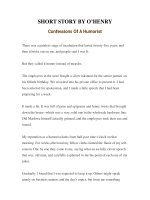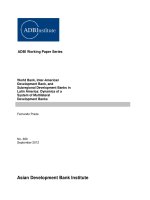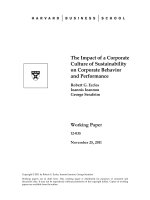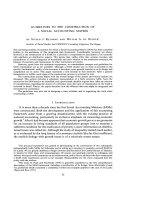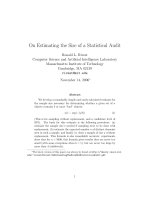confessions of a microfinance h - hugh sinclair
Bạn đang xem bản rút gọn của tài liệu. Xem và tải ngay bản đầy đủ của tài liệu tại đây (1.58 MB, 251 trang )
CONFESSIONS OF A
MICROFINANCE HERETIC
CONFESSIONS OF A
MICROFINANCE HERETIC
How Microlending Lost Its Way
And Betrayed the Poor
HUGH SINCLAIR
Confessions of a Microfinance Heretic
Copyright © 2012 by Hugh Sinclair
All rights reserved. No part of this publication may be reproduced, distributed, or
transmitted in any form or by any means, including photocopying, recording, or other
electronic or mechanical methods, without the prior written permission of the
publisher, except in the case of brief quotations embodied in critical reviews and
certain other noncommercial uses permitted by copyright law. For permission
requests, write to the publisher, addressed “Attention: Permissions Coordinator,” at
the address below.
Berrett-Koehler Publishers, Inc.
235 Montgomery Street, Suite 650
San Francisco, California 94104-2916
Tel: (415) 288-0260, Fax: (415) 362-2512
www.bkconnection.com
Ordering information for print editions
Quantity sales. Special discounts are available on quantity purchases by corporations,
associations, and others. For details, contact the “Special Sales Department” at the
Berrett-Koehler address above.
Individual sales. Berrett-Koehler publications are available through most bookstores.
They can also be ordered directly from Berrett-Koehler: Tel: (800) 929-2929; Fax:
(802) 864-7626; www.bkconnection.com
Orders for college textbook/course adoption use. Please contact Berrett-Koehler: Tel:
(800) 929-2929; Fax: (802) 864-7626.
Orders by U.S. trade bookstores and wholesalers. Please contact Ingram Publisher
Services, Tel: (800) 509-4887; Fax: (800) 838-1149; E-mail: customer.service@ingram
publisherservices.com; or visit www.ingrampublisherservices.com/Ordering for
details about electronic ordering.
Berrett-Koehler and the BK logo are registered trademarks of Berrett-Koehler
Publishers, Inc.
First Edition
Hardcover print edition ISBN 978-1-60994-518-3
PDF e-book ISBN 978-1-60994-519-0
IDPF e-book ISBN 978-1-60994-520-6
2012-1
Project management, design, and composition by Steven Hiatt / Hiatt & Dragon,
San Francisco
Copyediting: Steven Hiatt
Proofreading: Tom Hassett
Cover Design: Kirk DouPonce, Dog Eared Design
This book is dedicated to the poor entrepreneurs struggling to create a better world for
themselves and their families, but in particular to those paying interest rates of over
100 percent a year to line the pockets of a few microfinance banks and their investors.
On a more personal note, I also dedicate this work of financial critique to the man
who first taught me finance: my grandfather, William Clark.
Contents
Foreword by David Korten
Preface
1 Thou Shalt Not Criticize Microfinance
2 Baptism in Mexico
3 Bob Dylan and I in Mozambique
4 Another Mozambican Civil War
5 The “Developed” World
6 Something Not Quite Right in Nigeria
7 Something Not Quite Right in Holland
8 In Front of the Judge
9 Rustling Dutch Feathers
10 Blowing the Whistle from Mongolia
11 Enter the New York Times
12 Collapse, Suicide, and Muhammad Yunus
13 The Good, the Bad, and the Poor
Appendix: Microfinance Economics 101
Notes
Acknowledgments
Index
About the Author
Foreword
By David Korten
Confessions of a Microfinance Heretic provides an insightful, well-documented, and
devastating look into the tragic reality of how a good idea was derailed by the same
mindless pursuit of financial gain that caused the global financial crash of 2008. It is
essential reading for anyone involved in microcredit and for all who are committed to
ending global poverty and injustice.
For some twenty years we have heard the story that microcredit is the cure for
global poverty:
An amazing visionary economist in Bangladesh named Mohammed Yunus founded
the Grameen Bank and demonstrated a simple, effective way to end world poverty.
Small, low-cost loans to the poor unleash their entrepreneurial potential and allow
them to start profitable businesses that bring prosperity to themselves, their children,
and their communities.
It is a win–win solution that doesn’t require charity, redistribution, rethinking
economic policy, or restructuring existing economic institutions and relationships.
Global investments of a few billion dollars can earn an attractive financial return for
socially responsible investors and simultaneously banish the scourge of poverty.
That’s the widely received story. The reality that Hugh Sinclair documents in this
book presents a very different picture.
Too Good to Be True
Microfinance is now a $70 billion industry and some investors and microfinance
institutions enjoy eye-popping returns. The industry falls far short, however, of
fulfilling its promise to end poverty. Indeed, as Hugh Sinclair spells out in detail,
many microcredit programs are nothing more than predatory lending schemes
rebranded as socially responsible investment opportunities.
There are effective microcredit programs. Sinclair describes one in Mongolia that
truly serves the poor with low-cost loans used to fund successful microbusinesses.
Tragically, these may be more the exception than the norm.
I lived and worked in Asia from 1978 to 1992 as part of the foreign aid
establishment. During this time I regularly served as a consultant to several
Bangladeshi nongovernmental organizations (NGOs) that were pioneering
microfinance along with other innovative programs serving the poor. Two that I
particularly admired at the time as world-class models of positive NGO leadership are
now major players in the international microfinance industry.
Even back in the 1980s, I was concerned that microlending programs could draw
energy away from efforts by these same NGOs to address the deeper structural causes
of poverty. I also worried that such programs might leave the poor even more
dependent on financial institutions over which they had no control.
The microfinance industry Sinclair documents has been corrupted far beyond my
worst fears.
Our Human Capacity for Self-Deception
Sinclair predicts that microfinance insiders will seek to discredit him and use vicious
attacks to dismiss his conclusions. I urge those who may feel persuaded by these
attacks to bear in mind what Nobel Prize winner Muhammad Yunus said in a 2011
New York Times op-ed. He noted that when he founded Grameen Bank in Bangladesh
in 1983, “I never imagined that one day microcredit would give rise to its own breed
of loan sharks. But it has.”
Some of those responsible for the corruption of a noble idea may be true
scoundrels. Several of the organizations Sinclair implicates in this volume, however,
are led by individuals I have known personally as people of admirable ability, ethics,
and intention.
Sinclair’s insightful assessment of how even the industry’s most honest and
respected leaders become trapped by the imperatives and self-justifying stories of the
institutions they head is an important contribution of Confessions.
I can relate to their experience. I worked in various capacities with and within the
foreign aid system for some thirty years—rarely questioning its basic premise. It was
little more than two months after leaving my post with USAID as Asia Regional
Advisor on Development Management that a fresh insight hit me. Foreign aid, as
practiced, is almost inherently destructive, because it increases the dependence of poor
countries on the goods, technologies, markets, finance, and expertise of rich countries
and leaves them exposed to classical colonial exploitation in a new guise.
It is hard to see the truth of a system on which your pay and prestige depend.
Follow the Money
To my surprise and shock, I once heard a microlending advocate make the amazing
claim that high interest rates are a rich people’s concern. They don’t matter to the
poor. To benefit the poor, microcredit need only offer lower interest rates than local
money lenders.
Those who work in microfinance commonly view the system from the perspective
of the investor rather than that of the community and thereby lose sight of the bigger
picture. Tara Thiagarajan, chairperson of Madura Micro Finance, a for-profit
microcredit program in India, is an all-too-rare exception—as revealed in her
insightful May 2, 2010, blog:
The local moneylender … may charge a higher interest rate, but being local will
probably spend most of that income in the village supporting the overall village
economy. So potentially, local lending at higher rates could be more beneficial to
the village if the money is in turn spent in the village, compared to lower rates
where the money leaves the village.
Suppose that a microloan extended by an outside agency actually supports an
increase in village production. To cover the net outflow of rupees required to make
loan payments, the village must sell to outsiders more of what it produces just to get
rupees that immediately flow back out as loan payments. At the usurious interest rates
often involved, this can result in a substantial net loss. When the loan does not
contribute to an increase in productive output, which Sinclair notes is the most
common case, the net rate of outflow of both real wealth and rupees is even greater.
The same dynamic plays out at national and global levels.
Suppose that an investor in the United States invests in one of the microcredit
programs in India described by Sinclair. The investor provides loan or equity
financing in U.S. dollars and expects payment of interest and dividends in U.S.
dollars. The transaction between microlender and borrower in India, however, is in
Indian rupees. The invested dollars are exchanged for rupees in the foreign exchange
market and become part of India’s foreign exchange pool. The rich who need foreign
exchange to buy things abroad get the dollars. The poor microloan borrowers get the
rupees.
Interest on the rupee microloan flows quickly back out of the village in rupees to
the national microfinance institution. A portion of that outflow is then converted to
dollars that go to the U.S. investor abroad. This creates a negative drain on India’s
foreign exchange reserves that, given the rates of interest and profit Sinclair
documents, may add up to several times the original investment dollar inflow. To pay
this dollar obligation, India must produce goods and services for sale abroad. Or it
may sell or mortgage assets to foreigners, creating additional future claims against its
production and real assets.
In return for a short-term inflow of credit, the village and India as a country bind
themselves to a long-term outflow of claims on their wealth—supporting a classic
pattern of colonization and wealth concentration beneficial only to foreign interests
and their local accomplices.
Grameen Is a Bank
The key to fixing microfinance is to recognize the critical differences between the
Grameen Bank and the vast majority of microcredit institutions that claim to be its
replicas.
• Grameen is similar to what Sinclair calls a “regular” bank. Its lending is mostly
self-funded by local deposits in Bangladesh’s national currency, the taka.
• Grameen offers depository services with generous interest rates designed to help
its members build a financial asset base.
• Grameen extends loans to its members at a maximum interest rate of just over 20
percent, a fraction of what many other microlenders charge.
• Owned by its member savers and borrowers, Grameen is rooted in and
accountable to the community it serves. Profits and interest continuously recycle
locally to support productive local exchange and build real community wealth.
Grameen has its flaws, as does every institution, but it is designed to be locally
accountable and to build rather than expropriate community wealth.
Most of the microcredit programs that claim to replicate the Grameen model
resemble it only in the fact that they make loans to poor people. They are not “real”
banks with regular depository services. They are not owned by their borrowers. Some
charge interest rates of more than 100 percent. Interest and profits are siphoned off by
distant managers and foreign investors rather than recycling within the community.
Whether on Wall Street or in the villages of India, control of money by distant
financiers rewarded for seeking maximum personal financial gain is a path to outsized
wealth and power for the few and debt slavery for the many.
Even member/owner accountable banks that lend at reasonable rates are not a
magic-bullet solution to poverty. Grameen Bank, however, demonstrates that they can
be one useful tool.
It is time to rethink and restructure the microfinance industry in ways that take the
best of the Grameen model seriously. Instead of restructuring microfinance
institutions into publicly traded for-profits that sell shares to foreign investors, the
goal should be to restructure them as cooperative banks owned by their local
borrowers and funded in their national currency.
This model will not generate profits for foreign investors. That, however, was
never a proper purpose of microfinance.
Preface
The microfinance community often resembles a religious cult. Criticism is considered
heresy and is not tolerated. Impact on poverty is dogmatically claimed but
demonstrated in only exceptional cases. Above all, the sector is highly profitable, and
the origin of this profit is simple: the poor.
Criticizing microfinance thus antagonizes those who have power and money at
stake—the owners of the microfinance institutions (MFIs) and those who control their
funding. The goal of my heretical act in writing this book is to shed light on the actual
practices of the microfinance sector and to prompt changes that will skew the odds
slightly in favor of the poor.
I tried to influence microfinance from within, during a decade of work in the sector
across three continents and in a number of institutions. I tried logic and reason first,
but that strategy failed. I pointed out the immorality of exploiting the poor, but this
argument was ignored. Good, honest, hard-working microfinance practitioners were
gradually replaced with unscrupulous players with a simple motivation: profit. This
was disguised as a beneficial development, with coordinated publicity and attendant
hype. Naïve celebrities were employed for PR purposes, and large commercial banks
soon realized that there was a whole new client group to profit from.
Unfortunately, only negative publicity seemed to actually shake people into
corrective action, albeit begrudgingly. Slowly the popular press became aware of
some of the atrocities and touted them as typifying the sector, which was not
necessarily accurate; but such is the tendency of journalists seeking a scoop.
Specialized academic texts questioning the validity of the claims of the microfinance
sector do exist, but they are mostly technical, dry, and inaccessible to the average
reader. The book you hold in your hands attempts to bridge this gap.
I have attempted to go beyond the dinner table description of microfinance and
explain how the various players in the sector operate in practice, without venturing
into excessive technicality. I use the decade in which I worked in microfinance as a
backdrop. This decade coincided with the adolescence of microfinance, which before
2002 was a somewhat obscure niche of the financial sector. It is now a $70 billion
business and is featured on The Simpsons.
I beg the reader to not throw out the baby with the bathwater. Some microfinance
is extremely beneficial to the poor, but it is not the miracle cure that its publicists
would have you believe. Microfinance has been hijacked by profiteers, and we need
to reclaim it for the poor. The problem is not with a few rogue operators, alas, but
with systemic flaws that permeate the sector. I offer no easy solutions to fix this
problem, but the first step is to acknowledge it and identify its causes. In the
concluding chapter I offer the reader some tangible suggestions as to how best
maneuver within the microfinance sector.
We need to develop microfinance 2.0—a model that takes the lessons of the last
decades and applies them cautiously and prudently to the benefit of the poor. Making
modest profit from a well-run, competitive MFI is not unethical. Making millions of
dollars for a few individuals by charging eye-watering interest rates to vulnerable poor
women who cannot read the loan contracts they sign with a fingerprint is unethical.
Expecting a client to repay a loan is reasonable. Hounding a delinquent client unable
to repay her loan to the point of suicide is not. Claiming miraculous results with scant
evidence is optimistic at best, and more likely deceptive. Rigorous research by
independent, qualified academics and practitioners on the actual impact of
microfinance on the poor is the only way we will gather the data to understand what is
actually happening and how we can improve.
Microfinance 2.0 needs to be evidence-based and to balance fair returns with a
focus on positive impact. There is no room for exploitative greed in such a model.
Microfinance 2.0 will therefore require a culling of the less scrupulous players, who
will not go without a fight. Were the substantial sums of capital currently deployed in
the microfinance sector wisely applied, we could have a far greater impact on poverty.
Instead, we have settled for a poor substitute that enriches a few while enslaving many
with debts they can barely afford to service, let alone benefit from. We can do better.
The current state of the microfinance sector is simply unacceptable. The time for
playing ball with those responsible for this deception has now ended, and I urge
others who retain any faith in microfinance to do likewise. Microfinance 2.0 cannot be
created by individuals, but must be reconstructed collectively. This book is therefore a
call to action.
I have worked in microfinance for ten years. Since 2008 I have limited my work to
ethical, genuine microfinance operators, and my client list is correspondingly short.
Prior to this I was an insider, though one with ever increasing skepticism. I must
therefore acknowledge my own role in the rise of microfinance. But to become a
whistle-blower, or a heretic, one must first have been a member of the cult. Only by
working in these institutions, with many of the people mentioned in this book, was I
able to see what was actually taking place.
I remain convinced that well-designed, targeted microfinance to a subset of the
poor can have a positive impact. Microfinance is not suitable for all poor people, and
it needs to complement rather than replace other development strategies. Mohammed
Yunus set out with a grand vision to eradicate poverty with fairly priced microfinance
loans provided by institutions whose goal was to reduce poverty. But there was a
problem with the implementation of his vision—most MFIs do not offer fairly priced
loans and do not aim to achieve this goal. They have a myriad of excuses to justify
this, but the outcome is the same.
This book is aimed at those with a general interest in microfinance; industry
insiders; those who invest in microfinance via websites or dedicated microfinance
funds; celebrities who may have supported the sector with less than a thorough
understanding of what they were actually supporting; regulators who are charged with
protecting the interests of the poor and those of the investors in microfinance; and the
broader development community.
To respect the privacy of those individuals appearing in the book who are not
public figures, I have changed the names of most persons named in these pages. The
exceptions are senior figures and executives in the world of microfinance: the names
of these individuals have an asterisk on their first appearance, signifying the use of
their actual names.
Emails and documents referred to or quoted from will be available on the book’s
website with footnotes inserted in the text where appropriate. Links to websites will be
relegated to footnotes and also placed on the book website. Where incriminating
websites have been subsequently removed, the original screenshots will be uploaded.
One audio recording is reproduced in full in the text and will be available to listen to
on the website. A second audio recording is produced only partially in the text due to
its length, but the full audio recording and transcript will be available on the website.
Dialogue from a hearing of the U.S. Subcommittee on International Monetary Policy
and Trade is transcribed directly from the video footage available online.
For all other conversations and dialogue where a recording is not available, I have
reproduced these as accurately as possible, but these should not be considered as
verbatim. I apologize for the abundance of endnotes, but given the magnitude of the
claims and accounts of events that take place here, a rigorous approach to qualifying
such comments is prudent. The interested (or astonished) reader can verify the
sources at will. Most information is already publicly available, and the rest soon will
be; see www.microfinancetransparency.com.
Those with nothing to hide have nothing to fear.
1
Thou Shalt Not Criticize Microfinance
“I’m a dodgy moneylender, exploiting the poor with useless, overpriced loans, ideally
obliging their children into forced labor in the process.”
This did not go down well. I had been introduced to yet another gathering of
bright-eyed microfinance experts at yet another microfinance conference, and I had
incorrectly assumed that irony and sarcasm were within their grasp. They were not. I
attempted to redeem myself.
“Guys, I’m joking . . . it was a joke. I’m a microfinance consultant, we’re all cool .
. . sorry.”
I had broken the golden rule of microfinance, the unwritten code that bonds its
practitioners together. I had criticized microfinance and, perhaps worse, I had
implicitly challenged the developmental claims the sector proclaims so vehemently.
This is unacceptable from an insider. But none of the experts offered a defense or
rebuked my confession. Such comments cut a little too close to the nerve to warrant
further conversation. It is usually better to discuss the weather or the palatial décor of
the conference rooms instead.
Lack of tact had once again led me into an awkward situation, but it could have
been worse. Twice I have narrowly avoided being punched in conferences for daring
to suggest that microfinance was in fact falling a little short of miraculous.
There is actually surprisingly little evidence supporting microfinance as a practical
tool of poverty reduction, but this rather critical detail is ignored within the
microfinance sector for one simple reason. Microfinance does not apparently require
evidence to prove it works—since, on the face of it, it seems to work. It works
because the poor repay loans, and this is all the proof the sector requires. Some 200
million people now receive microfinance loans,
1
most of whom repay the loans.
Therefore they miraculously became better off in the process. So the argument goes.
The majority of credit card holders in the U.S. and Europe pay their bills
eventually, so therefore they too are becoming wealthier by the day thanks to Visa,
MasterCard, and American Express. The argument is no more complex than this. The
fact that a large proportion of these micro-loans are used for consumption, or to repay
other loans, or to pay off the evil village moneylender, is irrelevant.
The fact that crippling poverty persists in countries like Bangladesh, India,
Nicaragua, Nigeria, and Bolivia is seen as an irrelevant detail. The persistence of
poverty means that we need more microfinance. When Indian women started
poisoning themselves under the burden and shame of chronic overindebtedness, or
when the citizens of an entire country refused to repay their microfinance loans
claiming unfair treatment, those who provided the loans remained silent or claimed
that it all had nothing to do with them.
Many people do rather well out of microfinance, and celebrities from Bono to the
Clintons, President Fox of Mexico, and the Queen of Spain have jumped on the
bandwagon. The sector is of course extremely proud of its Nobel Peace Prize–winning
godfather, Muhammad Yunus.* Yunus had embarked on a courageous mission to rid
the world of poverty using fairly priced microloans to entrepreneurs. Alas, those
charged with achieving this globally had a slightly different vision. Even Yunus
himself has criticized the microfinance sector for the extortionate interest rates some
microfinance institutions (MFIs) charged, accusing such institutions of becoming
precisely the loan sharks that microfinance had initially sought to replace. Yunus’s
flagship institution, Grameen Bank, with whom he shared the Nobel Peace Prize,
charges interest rates of about 20 percent
2
—enough to make any mortgage-holder in
the developed world weep, but actually very reasonable in the microfinance world.
The fact that Grameen Foundation USA had inadvertently supported and invested in
at least one bank that charged rates six or seven times higher has been largely
ignored.
3
Microfinance is a $70 billion industry, employing tens of thousands of people,
predominantly managed by a closed group of funds based in the U.S. and Europe
acting as gatekeepers of the private capital available, and increasingly some of the
public funding as well. The industry is largely unregulated, opaque, and hard to
investigate in practice. A tireless PR machine recruits spokespeople, advertises on
television, and holds endless promotional events. An almost cultlike aura surrounds
the sector. Insiders are expected to toe the party line. It’s to all of our advantage to
belong to such an epistemic community with a common set of broadly held beliefs.
The cracks started appearing when Compartamos, a Mexican MFI, did the first big
stock market flotation of a supposedly “social” bank, netting a tidy $410 million for a
handful of lucky investors, financed in large part by ridiculously high interest rates
that the poor seemed bizarrely happy to pay. A few maverick academics had been
trying to sound the alarm for some years, and some insiders began to question the
fundamentals of pumping credit into mostly ineffective “businesses” at suspiciously
high prices. But as with all nascent bubbles, promoters perpetuated the hype.
Compartamos had woken people up to the fact that it was not merely a fringe of the
poor who would reliably pay interest rates of 100 percent or more for a loan of $200,
but hundreds of millions of them—the profit potential was massive. Forget sub-prime
—sub-sub-sub-prime was way better, and what’s more, there were few pesky
regulators to keep an eye on such inconveniences as consumer protection. A new gold
rush began.
The Department for International Development (DFID, the UK equivalent of
USAID), a traditional supporter and investor in microfinance, funded a major study of
the research surrounding microfinance and concluded that the entire exercise had been
mostly ineffective:
[I]t might have been more beneficial to explore alternative interventions that could
have better benefitted poor people and/or empowered women. Microfinance
activities and finance have absorbed a significant proportion of development
resources, both in terms of finances and people. Microfinance activities are highly
attractive, not only to the development industry but also to mainstream financial
and business interests with little interest in poverty reduction or empowerment of
women. . . . There are many other candidate sectors for development activity which
may have been relatively disadvantaged by ill-founded enthusiasm for
microfinance.
However, it remains unclear under what circumstances, and for whom,
microfinance has been and could be of real, rather than imagined, benefit to poor
people. . . Indeed there may be something to be said for the idea that this current
enthusiasm is built on similar foundations of sand to those on which we suggest
the microfinance phenomenon has been based.
4
While I do not refute the findings of this important report, I equally cannot refute the
evidence I have seen with my own eyes: that some microfinance is very beneficial to
the poor. I hope to explain how this dichotomy of opinions arises within the
microfinance sector.
I stumbled into the microfinance sector in 2002. Initially I shared the naïve belief that
microfinance was “the next big thing” and could genuinely assist the poor. The initial
signs looked promising to an untrained eye, and I joined the club in promoting the
panacea of microfinance.
The underlying concept of microfinance sounds so seductive. Ask a microfinance
expert what microfinance is and they will recount a heartwarming tale of a woman
living in a hut in some poor country who gets a minuscule loan to buy a productive
asset, often a sewing machine or a goat,
5
and by working hard she builds up a small
business that receives successively larger loans until she is eventually catapulted out of
poverty. Depending on the creative flair of the storyteller, the loans may also lead to
amazing benefits to her children and community, and phrases like “female
empowerment,” “human dignity,” and “harnessing entrepreneurial flair” will be
slipped in periodically.
This concept appeals to people in the “developed” world, many of whom are
increasingly skeptical of simply handing money to traditional charities after apparently
so few results of decades of this practice. Helping people to help themselves appears
more compatible with the ethos of developed countries: hard work and ambition,
competition, and developing new markets. The heroes of the NASDAQ are the
pioneers who take a simple idea and propel it to become a huge multinational business
—why not in developing countries also, on a smaller scale?
Microfinance touches on the core values of entrepreneurial vision, of teaching a
man how to fish rather than handing him a fish on a plate. It appears to be such an
excellent idea. Capital is loaned, invested wisely, recycled to the next wave of poor
people, investors in Geneva and Washington make a reasonable return in the process,
and soon poverty vanishes altogether. It appeals to the positive aspects of capitalism
and economic development, and it leverages the positive desire to work hard and
provide for one’s family. Everyone’s a winner. So how dare anyone ever criticize it?
The problems with these crass descriptions of microfinance blurted out at dinner
parties by zealous microfinance experts are numerous. Insiders are conditioned to reel
them off automatically, but many privately agree they are mostly fantasies. But the
fantasy is more palatable than to admit to having negligible impact while charging
high interest rates to the poor. We promote an end to poverty if only the poor would
take out a never-ending series of overpriced loans.
To cite a selection of the flaws of the romanticized image of the female
microfinance client living in the hut with the sewing machine:
1. Such cases are surprisingly hard to find in practice. Men often send their wives
to get loans because they know they are more likely to be approved.
2. Loans are almost invariably not spent on the productive sewing machine or goat,
but on a TV, repaying another loan to a very similar bank, paying other bills, or
general consumption. The benefits of the loan quickly disappear, but the debt
remains, accumulating interest at an alarming rate, often encouraging the client to
obtain another loan elsewhere to meet the repayments, often from the very
moneylenders the microfinance community claims to replace.
3. Interest rates on loans, when all the various hidden charges are considered, are
substantially higher than those stated. Interest rates under 30 percent a year are
disappointingly rare, and rates of 100 percent or higher are common. One
celebrated MFI in Mexico charges up to 195 percent per year.
6
4. The small business is rarely able to generate sufficiently massive returns over
prolonged periods to cover these interest payments. And even if the loan does
result in some genuine improvement to the life of the individual entrepreneur, it
is quite possible that this is at the expense of other people in the marketplace.
When Walmart opens in a town in America, many smaller shops are driven out
of business. According to the microfinance sector this phenomenon does not
occur in developing countries. We ignore the businesses that fail.
5. The number of people catapulted out of poverty is minimal, and no widespread
measurable reduction in overall poverty has been detected. At best, a few
individuals see their situations improve, and these lucky few provide the
examples for MFI marketing materials. The real debate about actual poverty
reduction fluctuates between it being marginal or negative. Serious belief in
Muhammad Yunus’s suggestion that poverty will be eradicated from the planet
and become a historical curiosity in “poverty museums” within a generation or
two is hard to find in practice.
6. It is assumed that every poor person is a budding Bill Gates. A quick glance at
the overwhelming majority of businesses that receive microloans hardly suggests
cutting-edge innovation—most market traders sell precisely the same products as
everyone else in the marketplace. Not everyone in Europe or the USA is a
budding entrepreneur, so why would we expect anything different in developing
countries?
7. The use of child labor is a carefully avoided question. The reality is that many
families involved in labor-intensive micro-enterprises employ their own
children, and no one knows the impact of such labor in the long term. As
universal education becomes a reality in more and more countries each year,
particularly in Latin America, it is likely that some of these children are stacking
shelves or selling cellphone cards at the expense of getting an education.
Conveniently, few microfinance banks and only one microfinance fund have
policies on child labor.
7
The self-regulatory watchdogs carefully avoid
discussion of child labor in their “Client Protection Principles.”
8. Most microfinance clients are not part of the “extreme poor.” In fact, quite a few
are perhaps best described as lower middle class, and while it is a pity that
commercial banks will not lend them money on reasonable terms, it does not
follow that an MFI offering them a loan at 60 percent interest per year to buy a
TV is necessarily contributing to development.
9. The clients of most MFIs are not generally covered by the regulatory protection
afforded to people in more developed countries.
10. When joining groups of borrowers who guarantee one another, one rather
unpleasant downside is overlooked for the defaulting client—not only do they
incur the wrath of the MFI, which can be quite oppressive, but they also lose
their friends, who are obliged to step in and meet the shortfall.
This list of valid questions to challenge the stereotypical microfinance loan is far
from exhaustive. In response, the sector is slowly acknowledging that it overhyped
microfinance, and that expectations of the imminent eradication of poverty were
perhaps optimistic. But the machine has been set in motion. Large commercial banks
have entered the sector, lured by the whiff of profit and the appearance of social
responsibility. Universities now offer courses in microfinance. There are microfinance
MBAs. There are even microfinance T-shirts. (See the appendix, “Microfinance
Economics 101,” for a quick review, and a critique, of the fundamentals of
microfinance theory.)
My concerns about microfinance took a decade to develop and involved extensive
travel across the globe, working with many of the key players and seeing
microfinance in action (for better or worse) from a variety of perspectives. I drifted
into the sector after prematurely finding myself unemployed two weeks after joining
the ill-fated Enron. Disillusioned with mainstream finance, microfinance seemed to be
an interesting, and perhaps more constructive, way to deploy a finance background. I
thus packed my bags and headed to Mexico full of optimism. As cracks began to
appear in the overall microfinance model, I initially assumed that they were
exceptions, teething problems, or temporary blips. But the cracks did not vanish, and
as the sector matured (if that is the right word), the propaganda machine worked
overtime to disguise rather than repair them.
There do exist cases where microfinance is genuinely benefitting the poor, but in
my experience these are few and far between. Accepted wisdom has come to believe
that access to microfinance is a necessary step in the direction of development. We
have managed to create a buzz around the very word microfinance that attracts
volunteers, the media, and celebrities. Muhammad Yunus goes as far as to suggest that
access to microfinance is a human right.
According to the generally accepted belief, the recent financial crisis was caused by
reckless bankers designing esoteric and complex financial products, and providing
loans to people who perhaps should not have bought a $1 million home in the first
place. Entire European nations racked up debts of astronomical proportions. People
began defaulting on their loans, governments could no longer service their debts, and
the house of cards began to collapse, necessitating the mother of all bailouts that
generations to come will have to repay. Meanwhile, MFIs across the developing
countries continued to hand out ever more over-priced loans to the poor, and many of
the investors in these MFIs managed to get a tax credit for such behavior since these
were considered ethical investments.
A few hiccups along the way were covered up, but dissenting voices began to raise
concerns. Some simply quit the sector entirely. A few funds closed the doors to
further microfinance investments. The first country to spectacularly and publicly
collapse was Nicaragua (previous collapses had been less public, such as Bolivia in
1999/2000). This raised some concerns, and cost the microfinance funds in Europe
and the USA some painful losses. Never mind—it wasn’t their money in the first
place, and the collapse was blamed largely on “the populist government.” Critical
documentaries and books began to emerge, and then scandals involving the darling of
the sector, Grameen Bank, finally hit the mainstream press.
With the benefit of hindsight most calamities can be avoided, but to understand the
crisis in microfinance, we must look beyond the propaganda. Histories of the
microfinance sector do exist, and they are generally pretty dry texts. The public
impression that microfinance was invented by Muhammad Yunus in some
Bangladeshi village in the 1970s is probably the industry’s foundational myth.
During the colonization of Indonesia in the early nineteenth century the Dutch
developed a system of financial services across the sprawling colony that bore a
striking resemblance to the current microfinance sector. Bank Rakyat Indonesia (BRI)
was formally founded in 1895, and to this day BRI is one of the world’s largest, if not
the largest, microfinance banks.
8
Wilhelm Raiffeisen founded a credit union in 1864 specifically to provide
affordable credit to farmers who otherwise relied on exploitative moneylenders for
credit. In Quebec, Alphonse and Dorimène Desjardins founded a credit union in 1900,
a forerunner to the North American credit unions, again in response to high interest
rates. Desjardins Group remains active in microfinance to this day. Although many
current microfinance operators have limited pedigree, Accion was founded in 1961
and began microfinance operations in Brazil in 1973. ShoreBank International was
launched in 1988. It largely depends on how we define microfinance, but it is likely
that some form of small lending activities predated even the Raiffeisen model.
Yunus was certainly a pivotal pioneer in the sector. He provided the sector with an
iconic figurehead from a poor and downtrodden country. By the end of the twentieth
century, microfinance was sandwiched awkwardly between the traditional
development sector and the formal financial sector. It was the unwanted child of each.
Many development specialists were skeptical of a practice so overtly commercial and
capitalistic in nature. Bankers were skeptical of a practice that focused exclusively on
poor people without collateral.
Early applications of microfinance beginning in the 1970s had yielded some
positive results, and practitioners began to dream of it becoming a key tool in the
eradication of poverty. There was certainly some profit to be made from microfinance
for those who provided the original capital if the banks could reach a sufficient scale.
It would require public acceptance to propel microfinance from the fringes of
development and finance to the forefront of the battle against poverty. The
microfinance strategy also fit well with a general disillusionment with traditional aid
sectors. Unleashing entrepreneurial flair was a more attractive proposal than handing
out free food. Bono summarized this succinctly: “Give a man a fish, he’ll eat for a day.
Give a woman microcredit, she, her husband, her children and her extended family
will eat for a lifetime.”
9
The general public was ready for a new approach to
development.
Thus after extensive campaigning, the UN declared 2005 as the year of microcredit,
and the following year it gained its ambassador. Muhammad Yunus received the
Nobel Peace Prize, and microfinance stepped onto the main stage. It was now firmly
acknowledged as a principal tool for development. Accelerated growth began, hugely
profitable stock market flotations were launched, and microfinance became a
household name. Presidents and rock stars opened conferences; specialist investment
funds began sprouting up like mushrooms; universities began offering courses in
microfinance; and the television messages of the “new cure for poverty” were beamed
into living rooms across the planet. But by 2011 Muhammad Yunus had been unfairly
fired from Grameen Bank under political pressure, the sector was facing widespread
criticism in the media, microfinance clients in India were committing suicide by the
dozen under the pressure of massive accumulated debt, and the sector was attempting
to reinvent itself.
Was Muhammad Yunus’s original dream flawed, or had the sector morphed into
an entirely different beast that now faced a serious challenge? When did the crisis
start?
I realized the magnitude of the crisis permeating the sector in 2009 when I received
a call from the managing director of Deutsche Bank asking me to cease my criticisms
of microfinance. I had been raising some awkward questions about a particularly
questionable microfinance bank in Africa that appeared to be making incredible
profits by exploiting the poor with extremely high interest rates. It had attracted some
of the largest investors in the entire sector, including Deutsche Bank, many of whom
claimed to be ignorant of the MFI’s underlying activities.
Senior people in the sector had invested in the African MFI in question, and they
were now appealing to me to keep quiet. I had visited this bank extensively, and I had
seen the poor women struggling to repay loans costing them over 100 percent per
year. It angered me and saddened me that the sector had morphed into little more than
yet another means for the rich to exploit the poor. I declined the offer to back down.
Some months later the incident landed on the front page of the New York Times,
explicitly naming Deutsche Bank, Calvert Foundation, and the darling of the public
face of microfinance—Kiva. The article caused a major stir in the sector, yet another
blow to the ludicrous hype that had been perpetuated for a decade about the miracle
cure for poverty. I played a significant role in getting this article into the New York
Times, and I knew that in fact this example was only the tip of the iceberg.
A subtle shift had occurred in the microfinance sector that Mohammad Yunus
himself pinpointed perfectly: “I never imagined that one day microcredit would give
rise to its own breed of loan sharks.”
A key problem in the sector is the distance, not simply physical, between the poor
recipients of microloans and those sitting in air-conditioned offices in Europe and the
USA running the sector. The words loans and clients are used interchangeably. Most
of those directing the capital that drives the microfinance sector have spent limited
time actually with the poor. Photos and stories are meager substitutes for meeting and
knowing the poor. In our case, and wife and I have spent eight of the last ten years
living in developing countries. The staff and clients of MFIs were not mere curiosities
to visit on a two-day trip to assess a potential investment in an MFI—they were our
neighbors and friends. We attended their weddings, and they ours. We bought stuff
from their shops and ate with them. We found that their situations are complex and
challenging and not easily resolved with a $100 loan.
I enjoy visiting their small businesses and chatting with them about how their
markets operate, the competition they face, their future plans. But I often leave
wondering if credit is what they actually need. Some modest training, some advice on
managing inventory, or strategic help on how to turn their plans into reality—these
may be far more helpful than a $100 loan at 60 percent interest a year, but this kind of
assistance is generally not available. Some MFIs offer such support, which I applaud.
But I believe that in the sector’s quest for relentless growth we have lost sight of the
human element at stake: the poor are people. They may deserve access to credit, but
they certainly deserve respect and fair treatment.
During my decade in microfinance I worked with countless individual MFIs, the
rating agencies, and other transparency initiatives and service providers, including
consulting boutiques and IT providers to the microfinance sector. I worked with
microfinance funds and peer-to-peer lending platforms that channel money from
investors to the MFIs. I worked with large microfinance networks with global
operations, spoke in various conferences, and had some modest interaction with
public multilateral investors such as the Inter-American Development Bank. I was
fortunate to witness the rise and fall from grace of microfinance over this period,
from a variety of perspectives.
This period may be best described as the commercialization of microfinance
sector, when big banks and political ideology infiltrated microfinance to the highest
levels. What began as a good idea was gradually hijacked by large investors and a new
wave of dot-coms, muddled with media hype. Poverty reduction has been marginal.
Some clients have found microfinance more a curse than a blessing, at times driving
them to suicide. Most investment funds, acting as the principal intermediaries between
those with capital and the MFIs pumping out the loans to the poor, have little idea
about microfinance in practice, and are motivated by a perverse set of incentives that
benefit neither their own investors nor the poor.
Each time a scandal erupts the microfinance funds are placed in an awkward
position. If they admit they knew of the practices but did not challenge them, they
seem to have betrayed their very raison d’être. If they claim they had no idea, they
admit that their due diligence is sloppy. They are damned either way. Best to avoid the
question altogether.
The average person on the street has been spoon-fed a deliberately naïve view of
microfinance. Most individuals who have invested in microfinance have little idea
how their funds are deployed in reality, and many would be disturbed to find out the
truth. They cannot board a flight to Burkina Faso to check whether their $25
investment is being used wisely, so they entrust their money to a fund or a website
that offers assurances of incredible impact. They read the website and magazines
produced by their chosen intermediary and assume the claims to be true. Little do they
know that these institutions are largely unregulated in practice and have a rather
different view of microfinance from that presented in their magazines, stuffed full of
photos of poor women in action poses, bouncing out of poverty every second of the
day thanks to $25 loans.
Meanwhile the poor largely remain poor, even as billions of dollars in interest
payments are extracted from their pockets justified by a few isolated but celebrated
cases of successful tomato vendors splashed across the promotional materials of the
companies leading the sector. An article in Time World summarized it succinctly: “On
current evidence, the best estimate of the average impact of microcredit on the poverty
of clients is zero.”
10
To highlight the unusual range of opinions, contrast this with the conclusion drawn
by two-time Pulitzer-winning New York Times columnist Nicholas Kristof:
“Microcredit is undoubtedly the most visible innovation in anti-poverty policy in the
last half century.”
11
In my opinion the truth is likely closer to the former than the latter. While the poor
are being deceived about the impact an over-priced loan will have on their actual
situation, so are many of the well-meaning investors who believe their money is being
put to good use. Microfinance can and does work if applied correctly. In practice it
largely does not. This is a pity, and a missed opportunity. It was not always like this,
and need not be like this. The sector morphed gradually over the last decade into its
current state of crisis. I saw this happen from the inside, and this is my story.

